Kazakhstan Seas and Lakes
lakes and seas of Kazakhstan
Kazakhstan offers unique lakes and seas for those who enjoy beach tourism, fishing, hiking to an alpine lake, or observing birds. Northern Kazakhstan holds most of the lake about 45%. While central Kazakhstan along with the southern part of the country has 36% and 19% of lakes spread in other regions.
The Caspian Sea
The Caspian Sea is the world’s largest inland body that is held or bordered by land on all sides. The Caspian Sea bathes the western part of Kazakhstan, located between Europe and Asia. Its name came from the Caspi people who lived in South Caucasus. Yet, the Persians and Greeks referred to the sea as the Hyrcanian Ocean.
The Caspian Sea is home to vast species as well as well known for its caviar and oil industries. However, pollution, mainly from the oil industry, is a primary threat to the sea’s ecology, with environmental bodies calling for controlled industrial activities in the region.
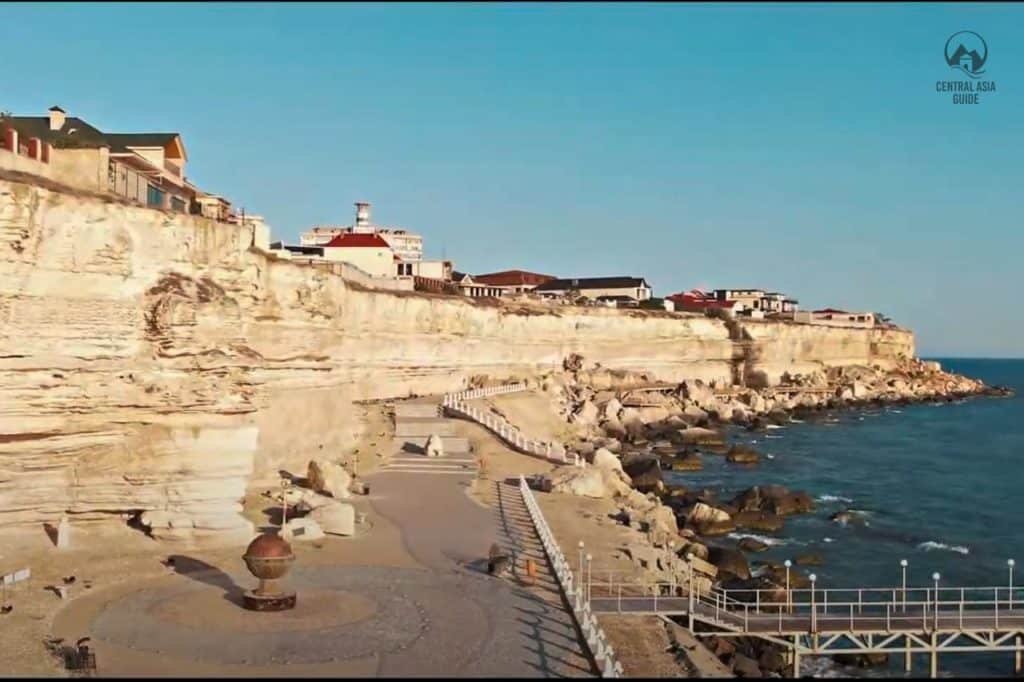

Aral Sea
Aral Sea is divided by Uzbekistan and Kazakhstan and is mostly known for the environmental disaster which has had, the once fourth largest lake in the World, to almost completely disappear. The Northern Aral Sea at the Kazakh side is now separated from the rest of the lake remains by a dam and the water level and salinity have started to improve there.
The eastern part of the Aral Sea has disappeared and in the western part only a narrow deeper part remains. It is descriptive that the eastern basin has been renamed as the Aralkum desert. Aral Sea could be considered a place of dark tourism as there are several ghost towns and ship graveyards surrounding the now dry sandy and dusty bowl where one can see thousands of seashells reminding of the more watery past. The reason for the lake getting dry is the excessive water usage of Amu Darya and Syr Darya.
Irrigation systems were built along these rivers already centuries or even more than a thousand years ago but in large scale the irrigation for cotton production started during the Soviet era and the shrinking of the Aral Sea really started to proceed in the 1960s.
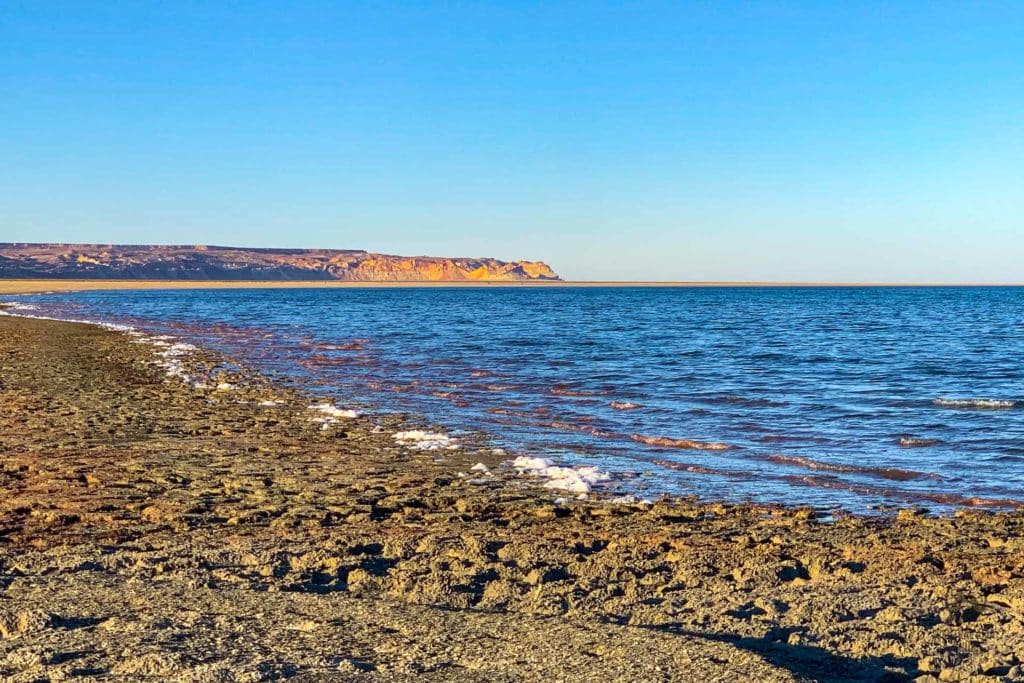
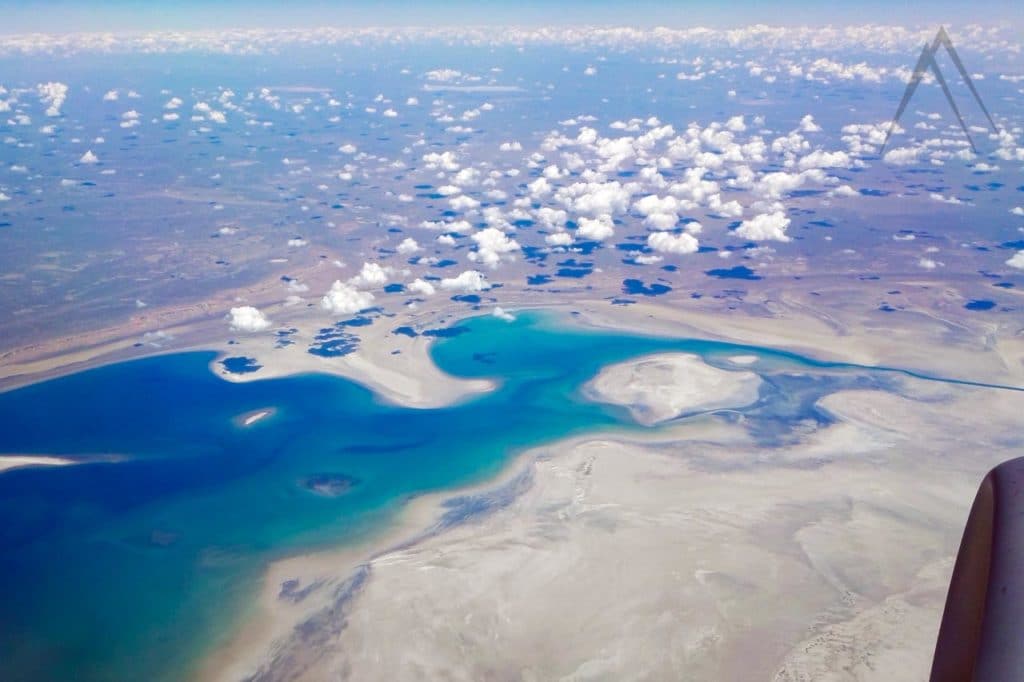
Balkash Lake
Balkhash Lake is an endorheic basin lake located in the South-Eastern part of Kazakhstan. Lake Balkhash is the second-largest lake in Central Asia by area (Northern Aral Sea is larger) and the 13th largest continental lake in the World and has the shape of a huge crescent. The lake width varies from just 5 km to around 70 km and it is 605 km long from west to the east.
The water of the lake is greenish and interesting as it is saline in its deeper eastern section, but freshwater in the more shallow western end of the lake. The main inflow into the lake is from the Ili River bringing freshwater to Balkhash. The lake has no outflow and it is usually frozen from November to March due to the cold winters of Kazakhstan. Lake Balkhash is the largest body of water without an exit after the Caspian and Aral seas.
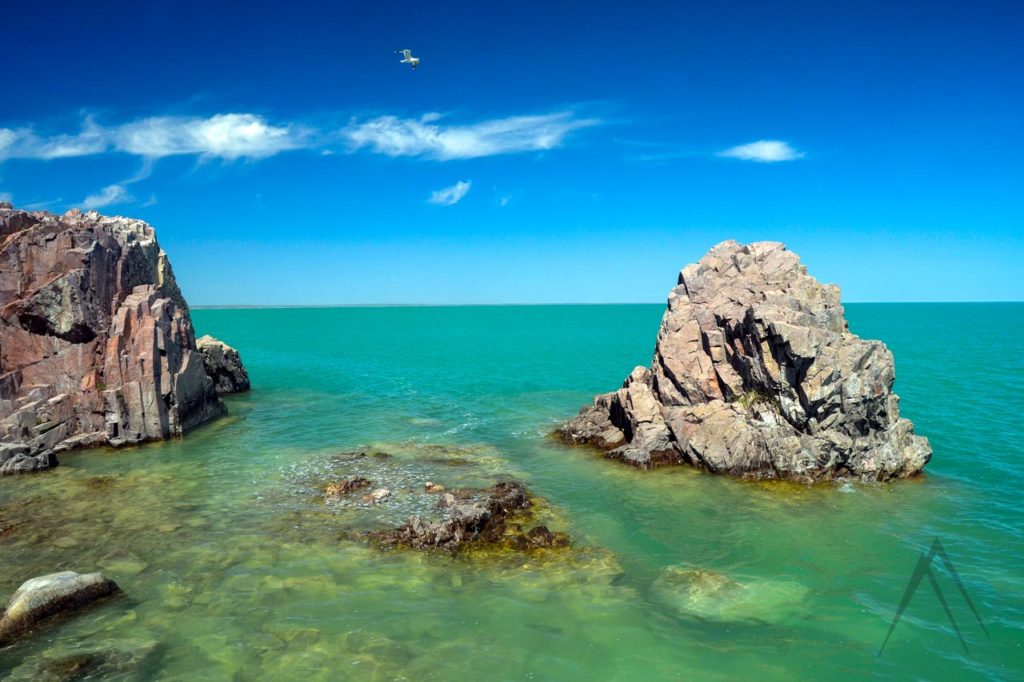
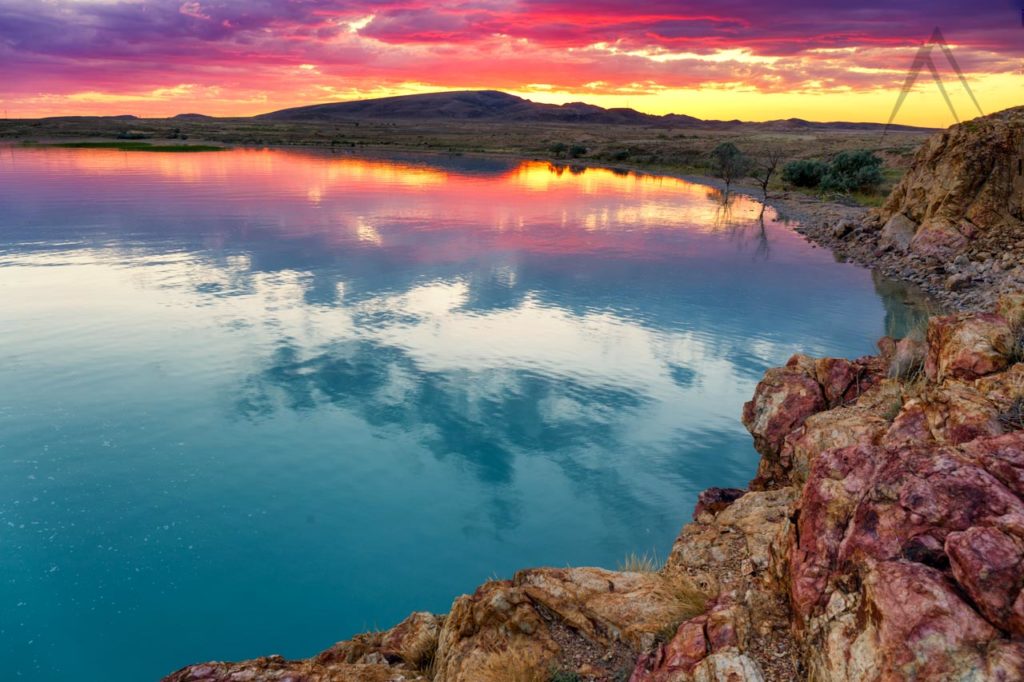
Zaysan Lake
Zaysan (or Zaisan) lake is the largest lake in Eastern Kazakhstan and one of the oldest lakes in the world as it was formed already approximately 60 million years ago. Zaysan lake stretches from southeast to northwest in a flat plain called the Zaysan depression at an altitude of 420 meters. The Zaysan depression is a tectonic intermountain depression between the Zhonghar Alatay mountains and the foothills of the Mongol Altai mountains and next to another geological sight called the Kiin Kirish valley and part of the shores of Zaysan are covered by similar geological formations.
Zaysan is filled by many rivers like the Black Irtysh, Kokpekty, Zharma, Kendirlik and others but only the Irtysh river flows out of it. The lake is 100 km in length, 22 – 48 km in width and used to cover an area of 1900 square km with an average depth of only about 8 meters. Due to the creation of the Bukhtarma hydroelectric power station, the area of the lake got at least doubled to 3500 km2 or even more.
Zaisan has unusually clean, transparent and soft water. There are no large settlements or industrial enterprises on the coast of Zaisan and therefore the ecological situation in the lake is favorable. Zaysan is famous for its abundance of fish, where the most valuable species is the trout.
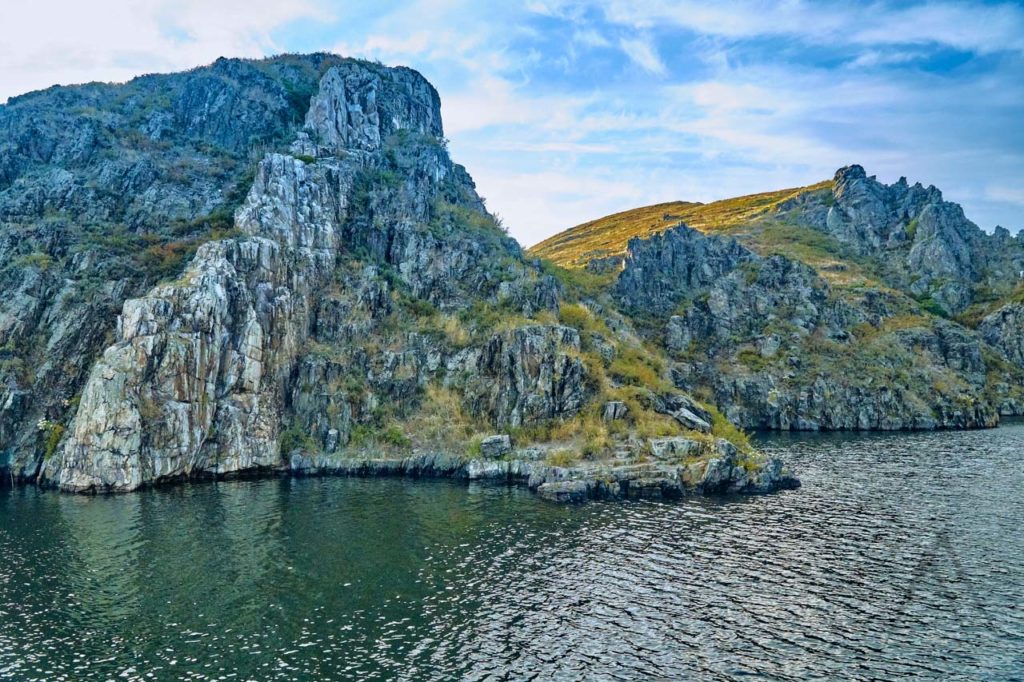
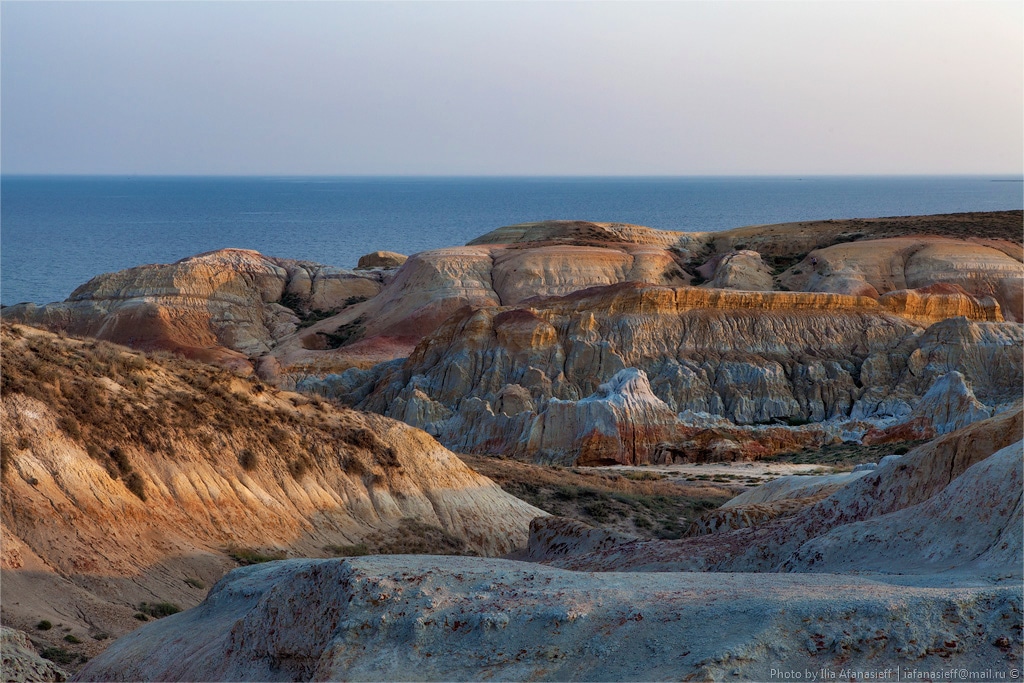
Kayindy
Kaindy lake is one of the most famous natural wonders of Kazakhstan, known for the narrow trunks of the spruce trees that rise up from its eerie blueish color water almost like in a horror movie and therefore some refer to it as the Dead lake of Kazakhstan.
Kaindy lake is located in the Chon-Urekty gorge, in the Tien Shan mountain system at an altitude of about 2000 meters above sea level and not very far from Almaty. The length of the lake is 400 meters and the depth is about 30 meters, making it significantly smaller and less deep than the Kolsai Lakes not far away, nearby the village of Saty. If you are visiting the area, make sure to visit both, Lake Kaindy and the Kolsai lakes. Lake Kaindy is also a part of the Kolsai lakes national park.
The Kaindy lake is very cold most of the time, having the highest temperature of only about 6 C during the summer (some still dare to walk in the part where the river meets the lake for great images). The chilly temperature keeps the underwater trees preserved in the lake. Otherwise they most likely would have already fallen down. The water in the lake itself regularly changes the color from the greenish to extra blue according to the light conditions meaning that the lake can look very different from different angles and during different weather conditions.
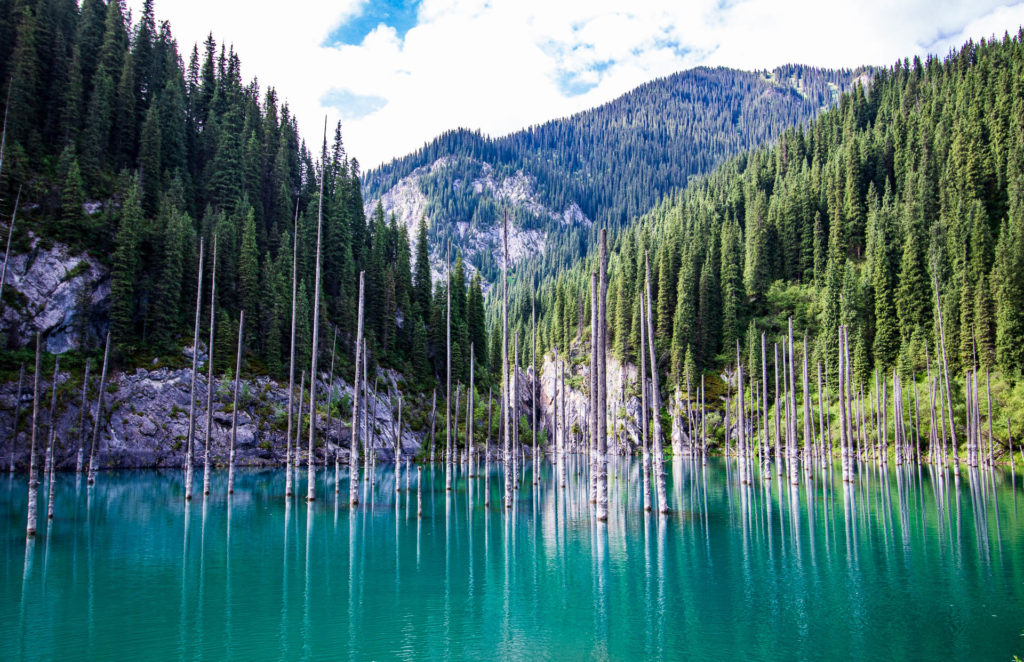
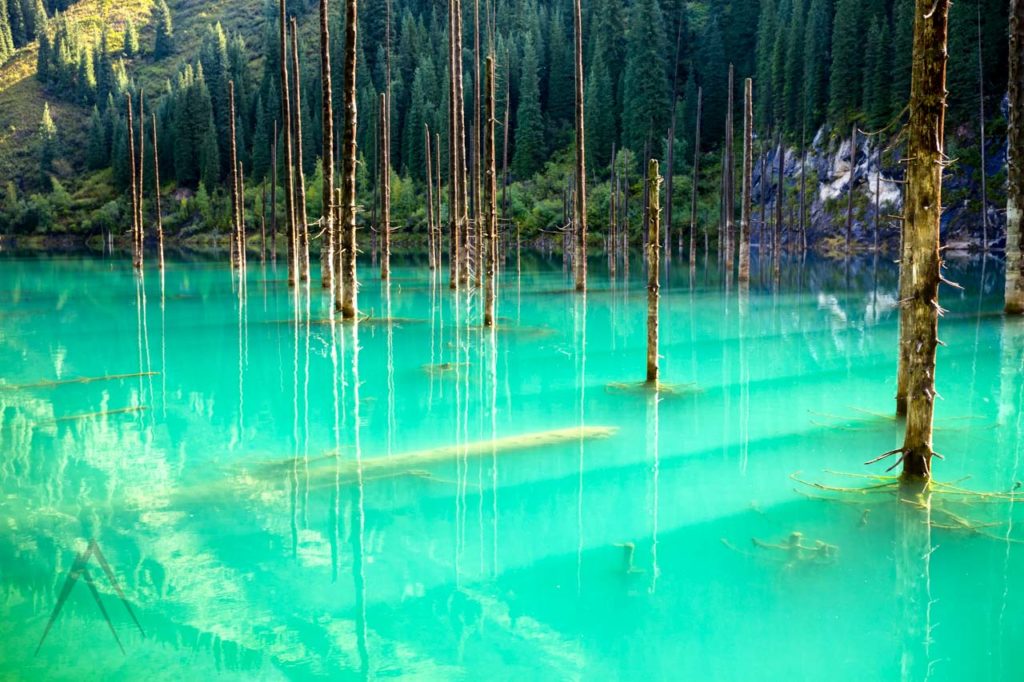
Markakol Lake
Markakol Lake is known as the “Pearl of the Altai”. The lake is located in the Eastern park of Kazakhstan nearby the Altai mountains. It is a 38 km long lake 19 km wide and up to 30 meters deep, rising at an altitude of more than 1,400m and close enough to the Chinese border so to get there a border zone permit is required. This great mountain lake is the most scenic of its kind in Kazakhstan.
The lake’s northern shore displays a wonderful view of the Sarymsakty Ridge, with its snow-covered peaks of Burkitaul, Eagle’s Eyrie, 3,373 meters, and Aksubas, Head of White Water 3,308 meters. For more than 100 rivers flow into Markakol Lake, however, only a single river, the Kalzhyr, flows out, south towards the Black Irtysh. The lake is famous for its crystalline water.
The lake and its surroundings of marvelous mountain taiga forest were officially declared a 75,000-hectare natural reserve in 1976. Around hills are forested with larch and silver fir, which host brown bear, elk, fox, lynx, and moral. The most significant ones are a fish locally called the “uskush”, a variety of the Siberian lenok, a trout. Some uskush can reach eight kilograms in weight and are a big draw for anglers
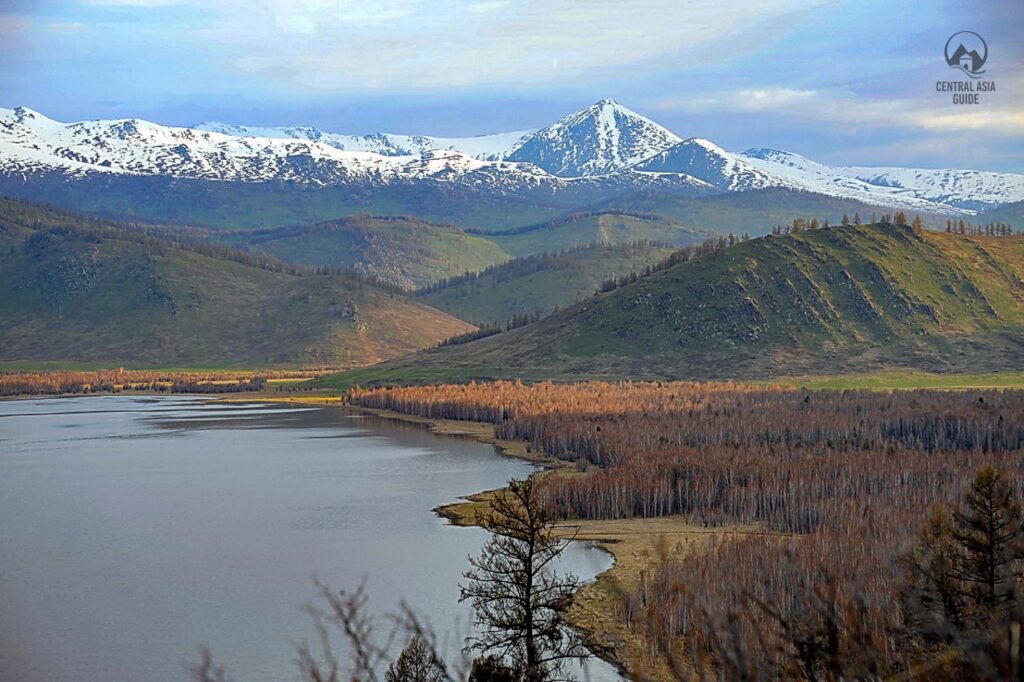
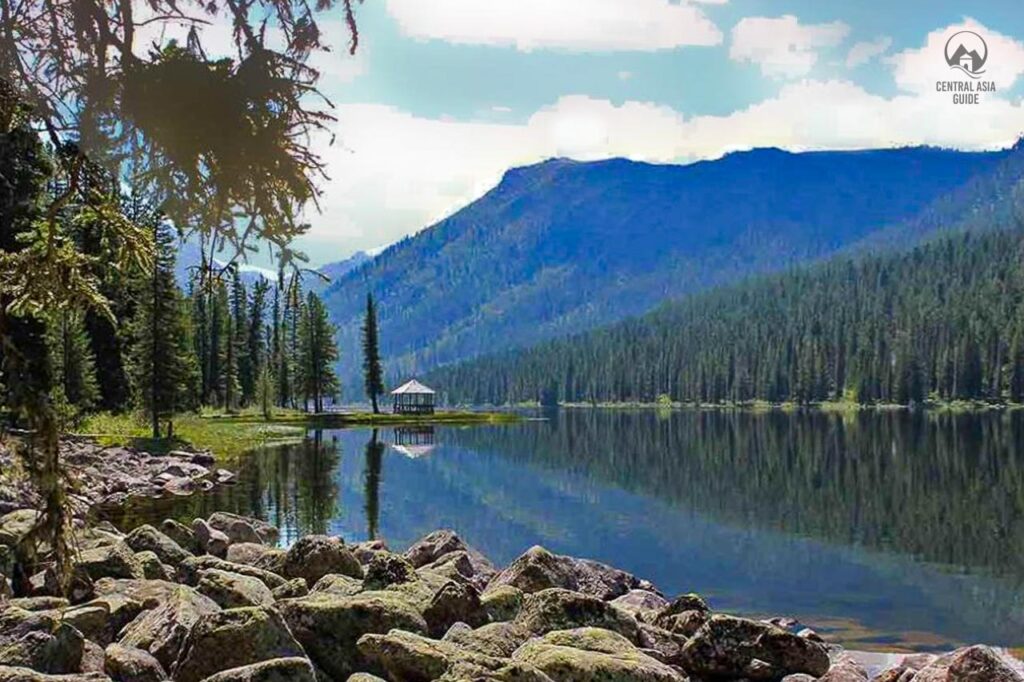
Lake Issyk
Issyk Lake, which is also known as Esik lake, is a bright-colored alpine lake enclosed by beautiful mountain nature and lush forests together with vast flower fields and can be found just a bit south of the village Esik in Southeastern Kazakhstan. The lake is located at an altitude of 1760 meters above sea level in the Issyk gorge of Trans-Ili Alatau and is located only about 70 km east from Almaty.
The birth of Lake Issyk occurred about 10 000 years ago when after a powerful earthquake caused a mountain to collapse and a large fragment of rock fell into the river valley resulting in 300 m high natural dam. Issyk Lake is fed with water from the melting glaciers of the Zailiyskiy Alatau.
The lake used to be a lot larger but in the summer of 1963, a gigantic mudflow destroyed the beautiful ancient lake. A stormy stream of stones, mud, the debris of rock, descending from the mountains and the Issyk River, swept away a natural dam on its way. In just five hours, the lake ceased to exist. Before this natural accident, the depth of Lake Issyk reached 80 meters, the length 1850 meters and the width about 500 meters.


Alaqol Lake
Lake Alakol translated from Kazakh means a “motley lake”. If a breeze is blowing and the water appears grayish, if the sun is shining, a soft blue color will be shown from the lake surface. If it will rain then the lake turns to reddish and if a storm is coming the lake can get ominous tones.
The water of the lake is clean but salty like a teardrop. The water is so transparent that you can see the fish scurrying between the algae at a depth of 2-3 meters. During the summertime, the water in the Alakol warms up to 24-26 degrees Celsius and a lot of locals arrive to spend their summer holidays at the shoreline, especially at the Eastern part of the lake. Otherwise the lake area is almost empty from human activity.
The northern shore of Lake Alakol is known as the healthy one. The water is famous for its mineral content, and curative mud attracts psoriasis patients. The pear-shaped Alakol Lake and neighboring hot springs have been popular since ancient times. Healing powers are also connected to the black shingle on the shore.
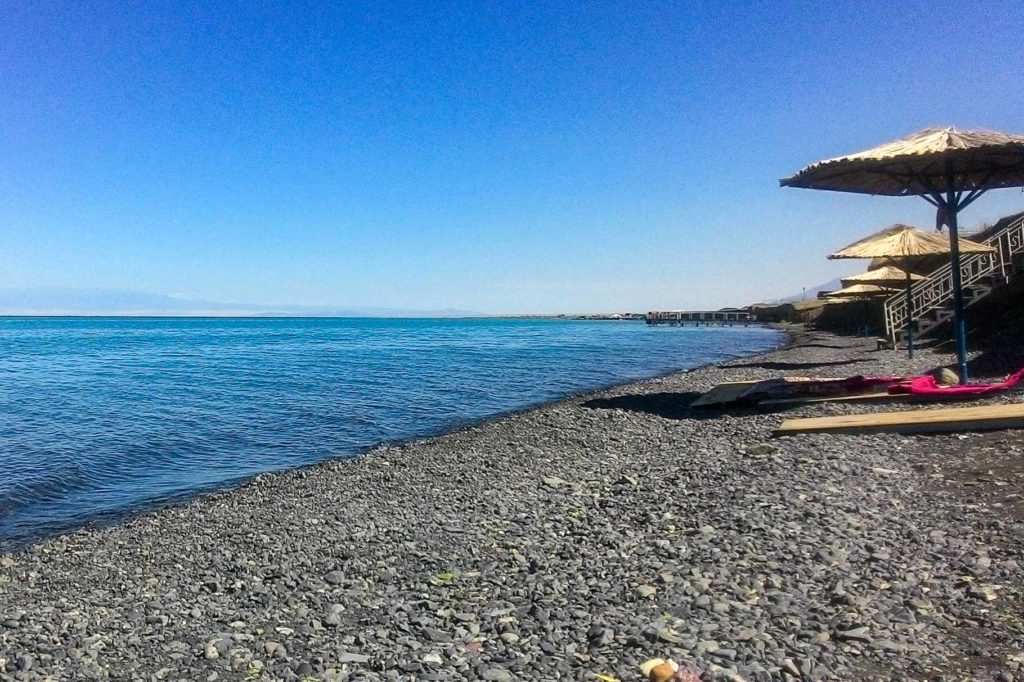
Kolsay lakes
Kolsai (Kolsay in Kazakh) is a system of 3 lakes located a 300 km drive southeast from Almaty, at Kungei Alatau mountain ridge which is one of the ridges of the northern Tien Shan, that limits in the North the Issyk-Kul basin, and follows in the South the Zailisky Alatau ridge. These two great ridges are divided from east by the large valley of Chilik river. Kungei Alatau is famous for its lakes, which are the real gems of the Northern Tien Shan in Kazakhstan.
The Kolsai lakes were formed due to a powerful earthquake that took place in the late 19th century. Huge amounts of stones and soil flooded the gorge in several areas and formed natural dams to the river that was running at the bottom of the gorge and thus creating the lakes. The color of all the lakes changes according to the weather from dark blue to turquoise or green and the water is very clear in all of them.
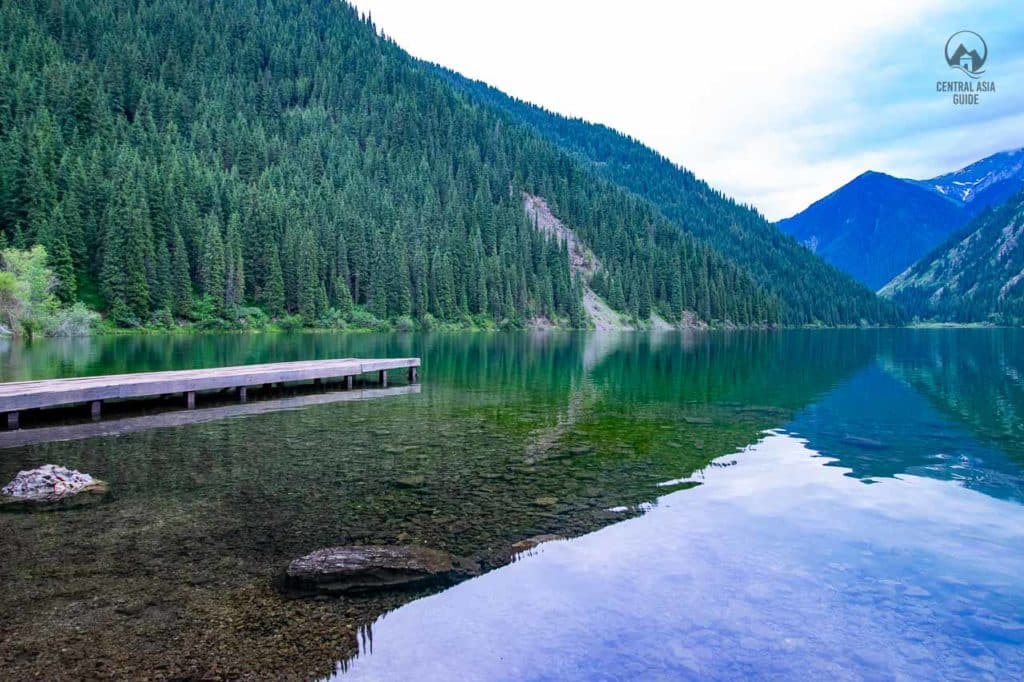

Baynaul lakes
Bayanaul lakes are located in the Bayanaul National Park about 450 km east of Astana. There are four large freshwater lakes in Bayanal:
Sabyndykol: The largest lake in the area is Sabyndykol. The name of the lake comes from the special water quality of the lake that reminds the texture of soapy water. When touching the water in the lake it feels soapy in your hand.
Zhasybay: The cleanest and perhaps the most popular lake in Bayanaul and the surroundings of Zhasybai is well developed with outdoor recreational infrastructures and at the shore, you can find a bunch of hotels, cafes, camps and entertainment centers.
Toraigyr: The third largest as well the highest lake above the sea level. This lake is less popular compared to the Jasybay as its water is not as clean. But in contrast the lake is rich with fish and you can find carp here.
Byrzhankol: Last but not least, Byrzhankol is located in the western part of the national park, somewhat apart from the other three. It is the smallest lake of the four, with a width of only about 800 meters. Additionally, some smaller lakes, some of which become significantly shallow in the dry season.

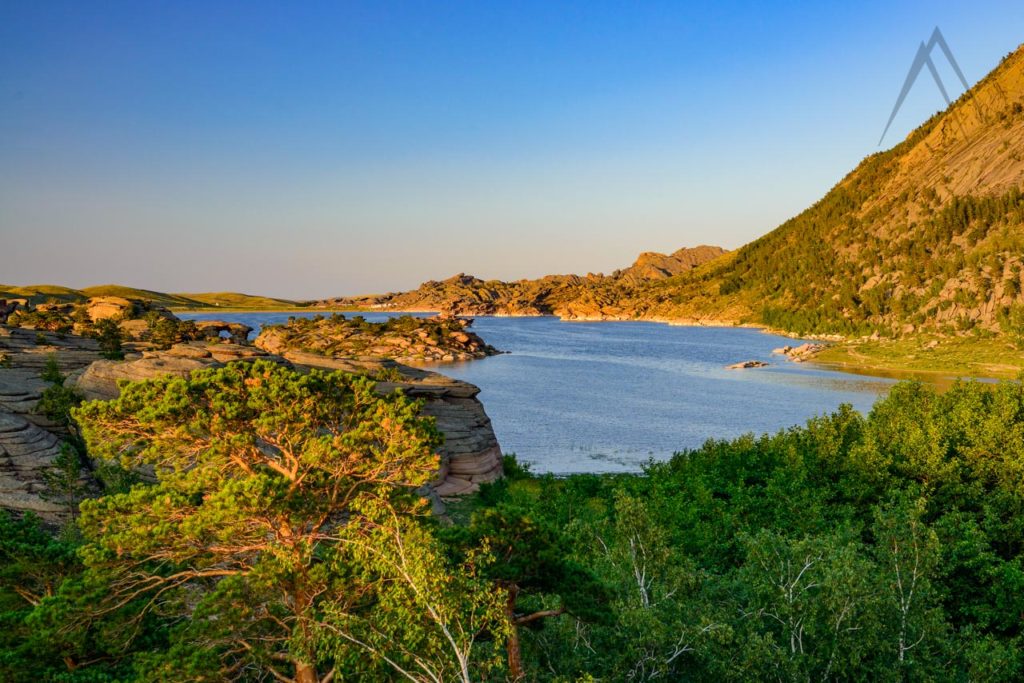
Big Almaty Lake
Big Almaty lake is known as BAO (Bolshoe Almatinskoy Ozero) in Russian and Zhasylkol in Kazakh, meaning the big blue Lake. The lake is located in the mountains of Zailiysky Alatau at an altitude of 2500 meters above sea level and was formed in the process of the movement of an ancient glacier. On the upper side of the canyon by the same name, the river is fed by the Almaty River running through it.
The lake is a part of the called Kok Zhailau plateau national park. The Big Almaty Lake belongs to the Bostandyk district of Almaty and is located 20 km South-East of the center of Almaty. Recently, the reservoir passes the state border with Kyrgyzstan, but the presence of a special pass to visit the BAO is not required. The lake lies in its places like a gleaming mirror, surrounded by all sides with majestic peaks and glaciers.
Three main peaks surrounding the lake can be seen from the Northern end of the dam built at the Northern corner of the lake: Sovetov 4,317 m to the Southeast, Ozyorny 4,110 m to the South, further up the river valley, and the forested slopes of Turist 3,954 m to the Southwest. Turist is the top of Bolshoi Almaty Peak, a 3,681 m high pyramid, which is also noticeable from the city center below. Supported by glacial water, the lake is 1.6 km long, almost one kilometer wide and 40 m deep.

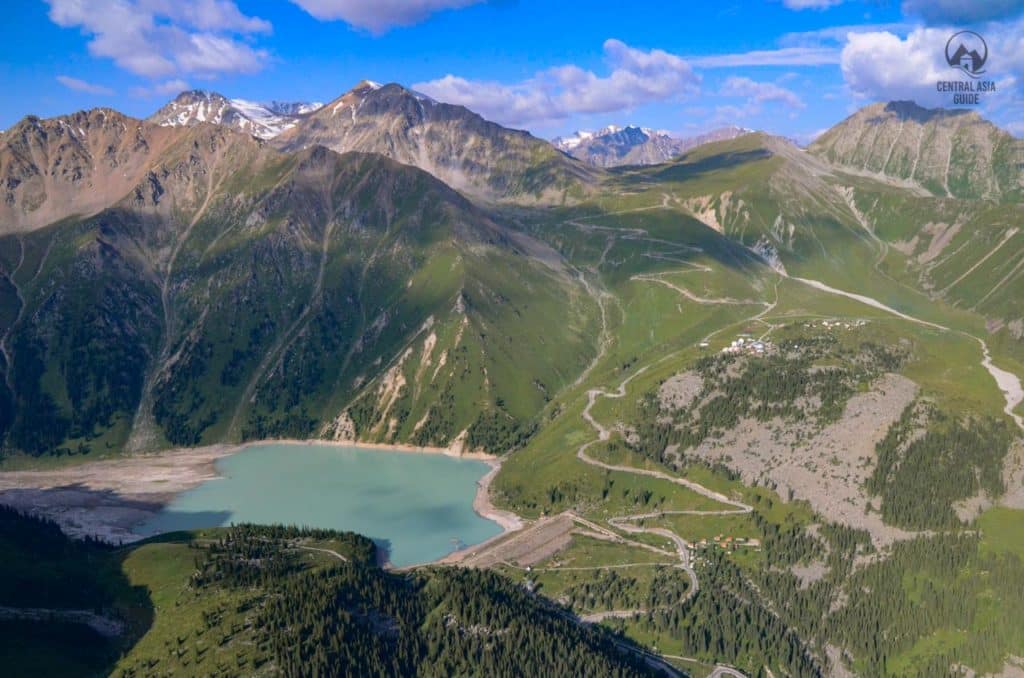
Tuzkol Lake
Lake Tuzkol (Tұzkөl in Kazakh) is a bitter-salty mountain lake placed at the left bank of the upper stretches of the Charyn river. It is situated in the Raiymbek district in the Southeast part of the Almaty region in the mountainous border of the Kegen depression about 70 km East from Kegen town along the highway to Narynkol East from Karkara valley in Kazakhstan.
The salinity of the water varies by season and can reach values comparable with the water salinity of the Dead Sea in Israel or the Great Salt Lake in the United States. The height of the lake is 1959 meters above sea level. It is a large lake with a length of 5 km and the width in some places is up to 1 km. The maximum depth of the lake is 3 meters and the average depth being only 0,3 meters.
Tuzkol is fed only from the groundwater and there is a small brook leading out to the Ili river basin. In clear weather, from the south shore of Tuzkol, you can see the majestic peaks of the Tien Shan as well as the pyramidal peak of Khan Tengri which lies at the altitude of 7010 meters above sea level and to the right, the trapezoid of Pobeda peak 7439 meters above sea level. In the northern part of the lake there are more than 10 cold springs with almost freshwater which then flows along picturesque channels towards the lake.

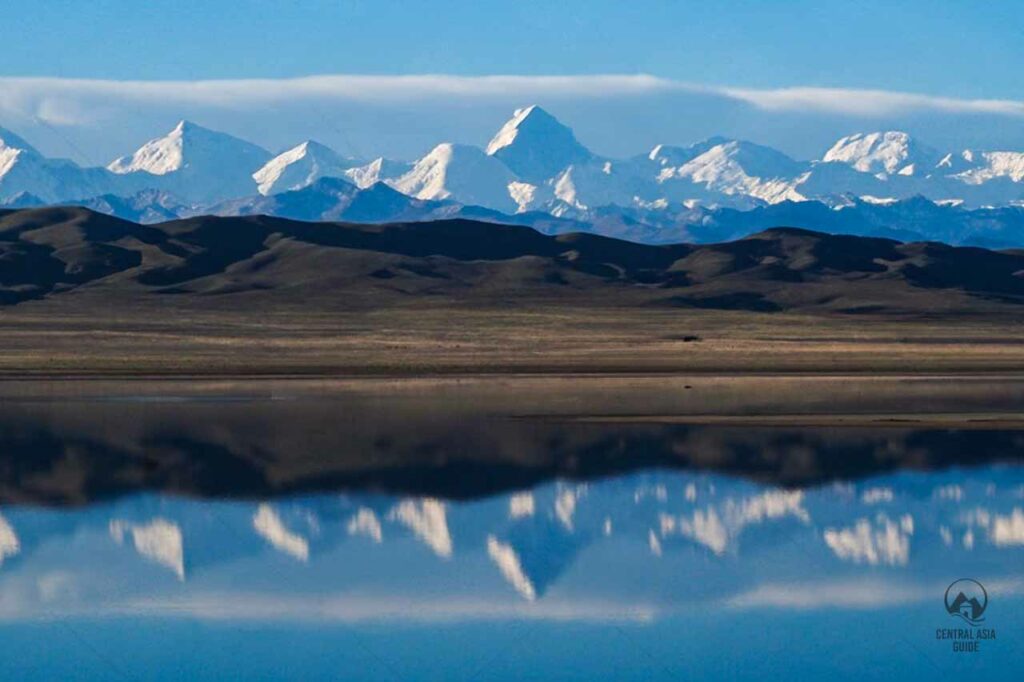
Tengiz Lake
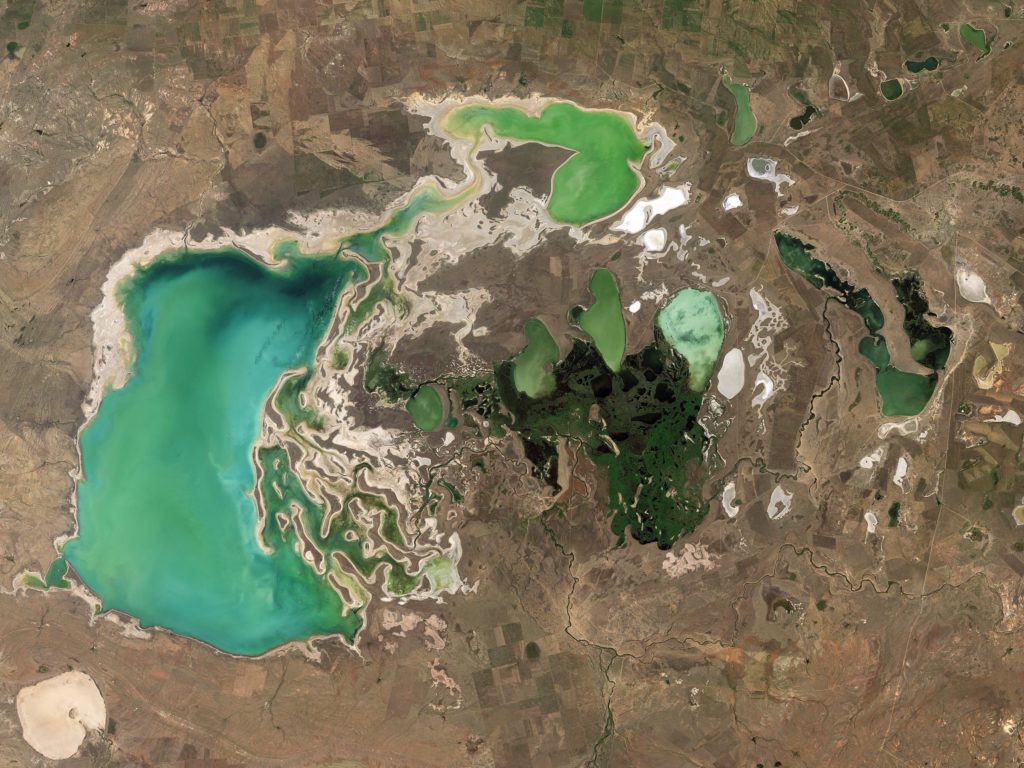
Lake Tengiz is a saline lake in steppes without an outlet. Tengiz lake takes in most of its volume from the Nura River, and the water is brackish. Tengiz lake is an important wetland site for birds and a part of a Ramsar wetland site of international importance, the Tengiz-Korgalzhyn Lake System.
Species of birds have been recorded at Lake Tengiz, 22 of which are endangered. The lakes of Korgalzhin are freshwater and are set in an immensely vast sea of reeds, home to tens of thousands of water birds Ornithologists have counted almost 330 species of indigenous and migrant birds, almost 20 of which are threatened with extinction. Lake Tengiz receives the northernmost and largest colony of pink flamingos in the world, with up to 14,000 pairs making their nests out on the lake.
More exotic lakes of Kazakhstan include the Pink lake in Astana region and the Blue lagoon lake.
Page updated 4.3.2023